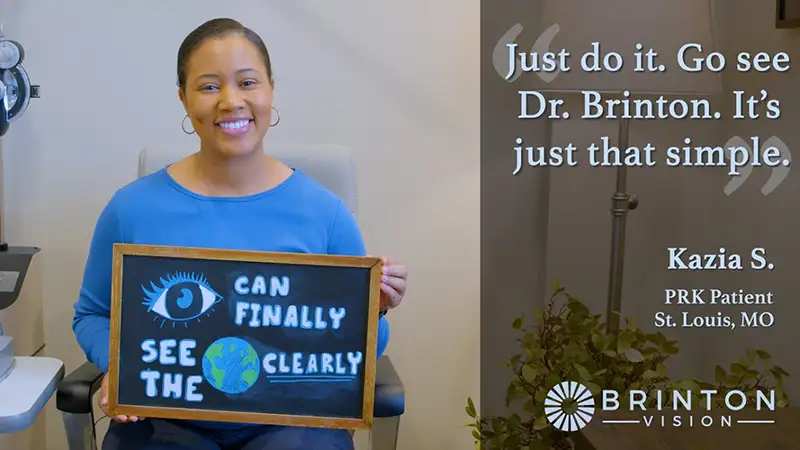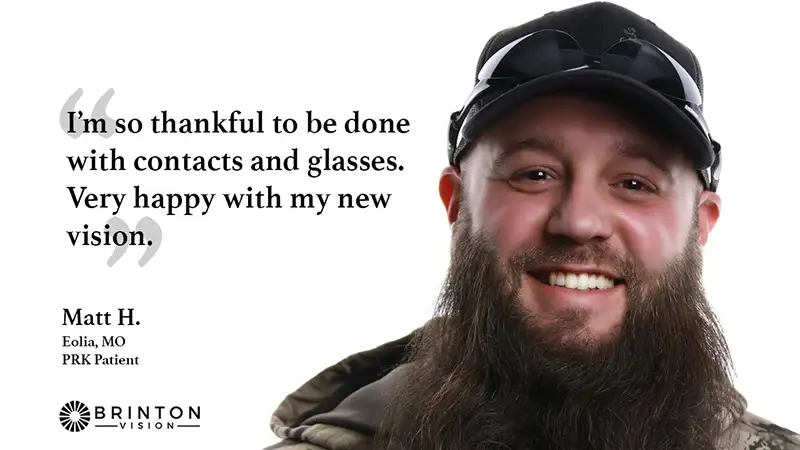PRK laser eye surgery
PRK surgery in St. Louis
LASEK/LASIK alternative
Photorefractive keratectomy, or PRK, is a laser vision correction solution available for a subset of laser eye surgery candidates who have special considerations such as thin or irregular corneas or patients who are in particular branches of the armed forces. For these patients, PRK eye surgery may be the best option for their journey toward visual freedom. (Because advanced surface ablation or ASA is an advanced version of PRK, you will see the terms ASA, PRK and Advanced PRK used interchangeably here.)
There are multiple methods of administering PRK. SmartSurfACE PRK, a version of trans-epithelial PRK (TransPRK), is one technique. In this procedure, a laser is used for both the first and second step of PRK – the laser removes the skin surface (epithelium) of the eye and also does the laser reshaping treatment. Alcohol, a brush called an Amoils epithelial scrubber , sponges, and various other instruments are also frequently used for the first step of the procedure, the removal of epithelium. If you are a candidate for PRK surgery, your surgeon will discuss options with you and choose the method best suited for your eyes.
Advanced PRK corrects nearsightedness, farsightedness and astigmatism, while providing you with exceptional visual results. It is different from other LASIK alternatives, however, in that PRK recovery is not rapid and the eyes are uncomfortable during healing.
ASA is one form of PRK. Other versions, such as LASEK and e-LASIK (epi-LASIK) are effective, but our doctors prefer ASA because they have observed quicker visual recovery with this surface ablation method compared to LASEK and epi-LASIK.
Are you a candidate for PRK?
Dr. Brinton is among the most experienced PRK eye surgeons practicing in Missouri, and can help you decide if PRK surgery is right for you following your comprehensive Brinton Vision Ocular Analysis.
What are the benefits of ASA/PRK?
- The Advanced Surface Ablation (ASA) variation of PRK provides excellent results when it is performed on the best candidates by the best PRK surgeons.
- ASA is a good option for people with thin corneas who are not good candidates for LASIK.
- It can enable people to enjoy activities they love, including very physical activities such as boxing or other contact sports, without the inconvenience of glasses and contacts.
- There is minimal downtime; most patients are back to what they enjoy doing within days.
- It is a more affordable option than the recurring costs of glasses and contacts, and there are several financing options available to fit PRK eye surgery into your budget.
Like custom LASIK plus its other modern alternatives, PRK dramatically improves your vision by reshaping the cornea. Instead of using a laser to create a flap in the cornea, PRK eye surgery involves the removal of the outer layer of the cornea, called the epithelium, to allow the laser eye surgeon to access the cornea, after which a laser reshapes the cornea to provide a lasting change to the curve and shape of the cornea.
PRK surgery is an effective procedural alternative to LASIK. Dr. Brinton has performed thousands of these procedures across the country. He is one of the most experienced PRK surgeons in Missouri, and his staff is well-trained in this laser eye surgery modality.
What is the difference between PRK and SBK/advanced LASIK?
The main difference between PRK and LASIK is that unlike LASIK, a PRK procedure does not require creation of a flap in the top layer of corneal tissue. Instead, the surgeon loosens and removes the thin layer of protective skin that covers the cornea. Then, an excimer laser, the same laser used in LASIK, is used to reshape your cornea to provide you with better vision.
This is especially helpful for people who are not good candidates for LASIK, including those with thin corneas, or for patients who have had infections or scarring resulting from contact lens wear. It also means, however, that the healing time for ASA is longer than that of LASIK (days and weeks rather than hours).
What is the difference between PRK and LASEK, transPRK, epi-LASIK, or e-LASIK?
In musical terms, these procedures are all variations on a theme. The procedures are close enough that some practitioners use PRK, LASEK (sometimes called epi-LASIK or e-LASIK), and trans-PRK interchangeably. There are subtle differences, however. During LASEK, the epithelial layer, or the clear skin over the eye, is loosened and pushed aside but is replaced at the end of the procedure. Think of it as being much like replacing a skin flap over a blister that has popped.
In contrast to LASEK, during PRK, the epithelium is completely removed. Patients wear a special contact lens to protect their cornea while the epithelium grows back. Our doctors have found that in their hands patients heal faster and are more comfortable when the epithelial layer is removed rather than repositioned.
How do I know if PRK surgery is right for me?
Brinton Vision is the only LASIK and vision correction surgery center of its kind in St. Louis. We provide LASIK plus all of its modern variations: SBK, PRK, CLR, EVO ICL, and SMILE eye surgery. To determine which procedure is best for your unique eyes and vision needs, we perform a comprehensive Brinton Vision Ocular Analysis (BVOA), which is one of the most thorough, modern examinations available anywhere. Your BVOA will arm our doctors with the information they need to determine if you are a candidate for vision correction, and if so, which procedure best fits your eye health and vision goals.
Are you ready to take the next step in your vision journey?
What to expect on PRK procedure day
In our St. Louis laser eye surgery center, Advanced PRK takes 15 minutes to complete. The visual freedom our patients obtain, however, can last a lifetime. On the day of the procedure, plan to be at Brinton Vision for about three hours. You will need someone to drive you home, as your vision will likely be frosty immediately following the procedure.
Just as if you were going to an eye examination, you don’t need to wear special clothes or change your attire while you’re here. The only thing we’ll add to your outfit is a small, blue cap, shoe covers, and a mask if you haven’t already worn one to the office.
Prior to beginning, we will repeat some of the same tests that were conducted during your Brinton Vision Ocular Analysis so our surgeons have the most accurate information possible about your vision.
When you’re ready for the procedure, numbing eye drops will be administered so that you are comfortable during your PRK. In a quick 15-minute procedure, the cornea is precisely reshaped to improve your vision.
After the procedure, you will receive easy-to-follow instructions and a written hand-out on how to use your eye drops. Our highly trained surgical technicians will answer any questions you may have and provide you with your surgeon’s personal cell phone number should you have concerns once you return home.
With PRK, you may need a couple of days of recovery time, as you can expect your eyes to feel irritated and uncomfortable. Within a week or so, you will notice what is often a dramatic improvement to your vision. In the meantime, we’ll follow you through your recovery and be there every step of the way.
Is PRK permanent?
The changes made to the cornea during PRK surgery are permanent – the tissue removed in the reshaping process doesn’t come back – however this doesn’t mean that the eye itself can’t age, separate from the procedure. For most PRK surgery patients, they can expect to enjoy clear vision until a predictable change arises in their mid-40’s called presbyopia. Presbyopia comes from Greek roots that mean “old eye.” At first, most patients with presbyopia continue to see clearly as they look around at the world around them. They just notice that it becomes harder to see fine print up close, especially in dim lighting. Presbyopia is an equal opportunity offender as we say at Brinton Vision. It affects everybody who lives long enough, and doesn’t care whether you wear glasses, contacts, or were born with perfect eyesight. It is an age issue and not a prescription issue. When presbyopia sets in, most of our patients come back to Brinton Vision for an adjustment of their eyes that keeps them from having to wear reading glasses. For those who choose to wear reading glasses instead, family or friends will often comment that their “LASIK wore off.” It’s important to understand that the loss of near vision is an age issue, and not an issue of LASIK, PRK, or eye correction surgery “wearing off.” At older age ranges if patients develop cataracts or other eye conditions such as macular degeneration or glaucoma, these diseases can still be effectively managed by a competent ophthalmologist whether or not a patient has had PRK or continues to wear glasses and contact lenses.




